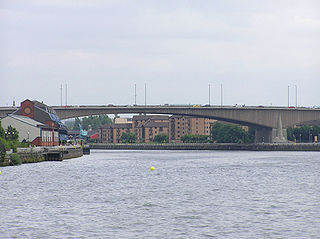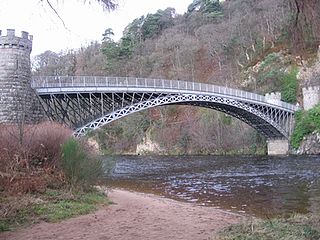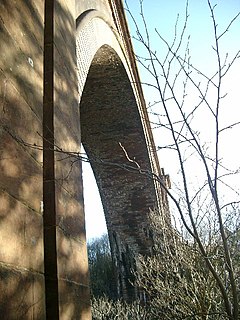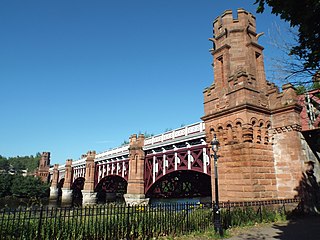
Thomas Telford FRS, FRSE, was a British civil engineer. After establishing himself as an engineer of road and canal projects in Shropshire, he designed numerous infrastructure projects in his native Scotland, as well as harbours and tunnels. Such was his reputation as a prolific designer of highways and related bridges, he was dubbed The Colossus of Roads, and, reflecting his command of all types of civil engineering in the early 19th century, he was elected as the first President of the Institution of Civil Engineers, a post he held for 14 years until his death.

The Kingston Bridge is a balanced cantilever dual-span ten lane road bridge made of triple-cell segmented prestressed concrete box girders crossing the River Clyde in Glasgow, Scotland.

Tradeston is a small district in the Scottish city of Glasgow adjacent to the city centre on the south bank of the River Clyde.

The Kelvin Hall, located on Argyle Street in Glasgow, Scotland, is one of the largest exhibition centres in Britain and now a mixed-use arts and sports venue that opened as an exhibition venue in 1927. It has also been used as a concert hall, home to the Kelvin Hall International Sports Arena to 2014, and from 1988 to 2010, Glasgow's Museum of Transport. As part of the economic redevelopment of Greater Glasgow promoted by the Scottish Development Agency and local authorities to enhance the city's tourist infrastructure and to attract further national and international conferences, the Scottish Exhibition and Conference Centre was designed as the Hall's successor for exhibitions and entertainments, built and opened on the nearby Queen's Dock in 1985 with an exhibition area equal in size to the Kelvin Hall but with the benefit of extensive car parks and land for other complementary buildings. The Hall is protected as a category B listed building, and is served by city bus services and by Kelvinhall subway station.

Craigellachie Bridge is a cast iron arch bridge across the River Spey at Craigellachie, near to the village of Aberlour in Moray, Scotland. It was designed by the renowned civil engineer Thomas Telford and built from 1812 to 1814. It is a Category A listed structure.

The Clyde Arc is a road bridge spanning the River Clyde in Glasgow, Scotland, connecting Finnieston near the Clyde Auditorium and SEC with Pacific Quay and Glasgow Science Centre in Govan. Prominent features of the bridge are its innovative curved design, and that it crosses the river at an angle. The Arc is the first city centre traffic crossing over the river built since the Kingston Bridge was opened to traffic in 1970.

The Kelvin Aqueduct is a navigable aqueduct in Glasgow, Scotland, which carries the Forth and Clyde Canal over the River Kelvin.

The Ballochmyle Viaduct is the highest extant railway viaduct in Britain. It is 169 feet (52 m) high, and carries the railway over the River Ayr near Mauchline and Catrine in East Ayrshire, Scotland. It carries the former Glasgow and South Western Railway line between Glasgow and Carlisle.

The Tradeston Bridge is a pedestrian bridge across the River Clyde in Glasgow which opened on 14 May 2009. It links the districts of Anderston to Tradeston and the neighbouring district of Kingston – the aim of the bridge being to aid the regeneration of Tradeston by giving it a direct link to the city's financial district on the western side of the city centre.

George V Bridge is a three-arched road bridge over the River Clyde in the city centre of Glasgow, Scotland, named after King George V.

The Dean Bridge spans the Water of Leith in the city of Edinburgh on the A90 road to Queensferry on the Firth of Forth. It carries the roadway, 447 feet (136 m) long and 39 feet (12 m) broad, on four arches rising 106 feet (32 m) above the river. The bridge was one of the last major works before retirement of the bridge designer, civil engineer Thomas Telford, and was completed in 1831 when he was seventy-three years old.

The Woodroad Viaduct, also known as Bank Viaduct or Templand Viaduct, is a viaduct carrying the Glasgow South Western Line over the Lugar Water at Cumnock in East Ayrshire, Scotland, United Kingdom. Since April 1971, it has been recognised as being a category A listed building.

The City Union Bridge is a bridge on the River Clyde in Scotland. It was opened in 1899. It was once a busy main route in and out of St Enoch station but that terminus closed in 1966 and was demolished in 1977, and since then the bridge is only used for empty stock movements, as the bridge forms a key link between Glasgow Queen Street and Glasgow Central. If a project known as Glasgow Crossrail goes ahead then the bridge and associated track will see passenger services once more.

The Caledonian Railway Bridge is a bridge crossing the River Clyde at Broomielaw in Scotland. It is adjacent to Glasgow Central station.
Events from the year 1816 in Scotland.
Events from the year 1834 in Scotland.
William Etheridge was an English civil engineer and architect, best known for his work on several wooden bridges of mathematical design.

Kingston is an area of Glasgow, Scotland, from which the Kingston Bridge takes its name. Together with Ibrox, it forms one of the 56 neighbourhoods of Glasgow defined by Glasgow City Council for operational purposes. The area was assigned to Ward 54 until 2007 when it was reclassified as part of the Govan ward.

The Old Spey Bridge is a footbridge on the outskirts of Fochabers in Moray, Scotland, which formerly carried the main road between Inverness and Aberdeen over the River Spey. Originally built between 1801–1806 by George Burn, it was partially destroyed in the Muckle Spate of 1829, with two of its arches being washed away. Archibald Simpson repaired the bridge in 1831 with a single timber span, which was reconstructed in cast iron in 1853. The bridge is designated a Category A listed building.
Charles Atherton was a British scientific engineer from Calne, Wiltshire. He was appointed as Chief Engineer and Inspector of Steam Machinery at Her Majesty's Woolwich Dockyard in 1847; and a second time between 1851 and 1862. He served in the same capacity at Her Majesty's Devonport Dockyard between 1848 and 1851.
















